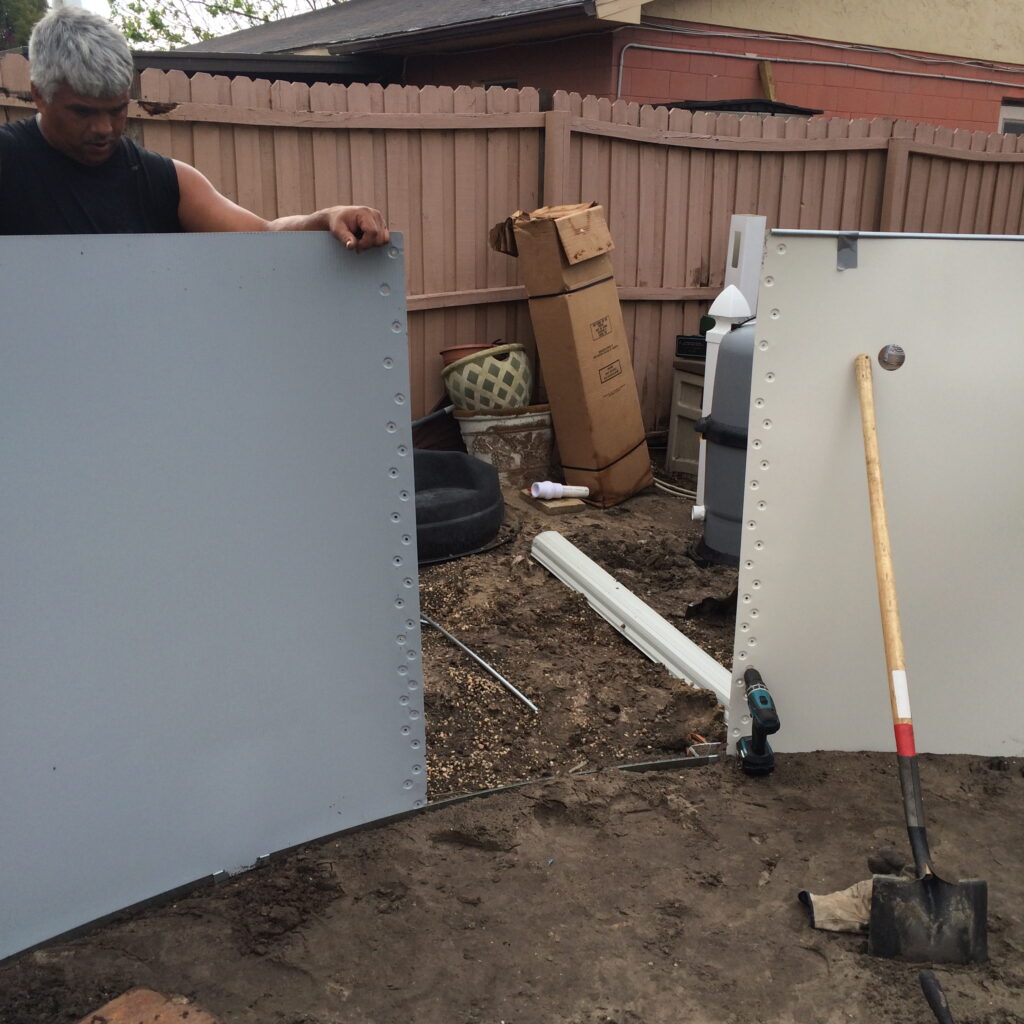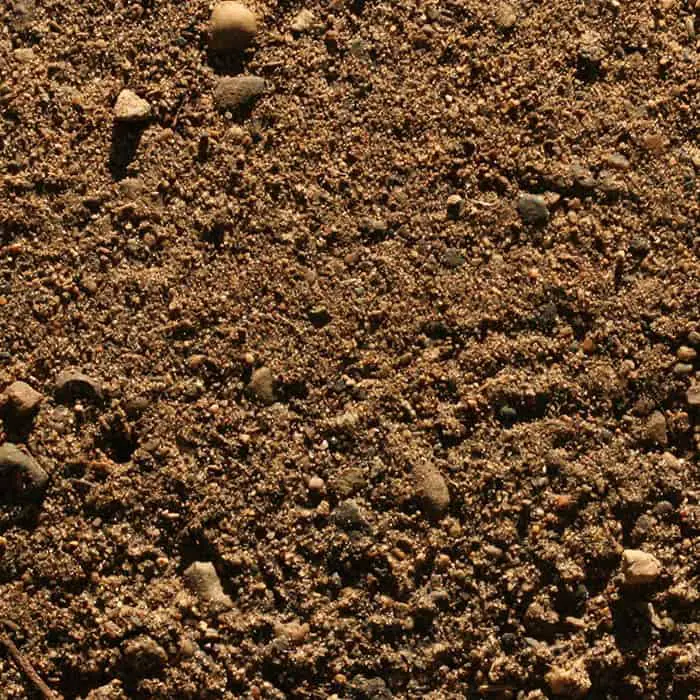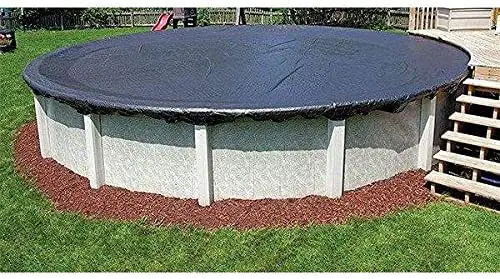If you have found this article, it’s because you are in a very specific situation. You are in the middle of installing your above ground swimming pool and are having a big issue – the wall of the pool does not fit!
I can imagine that you are pretty frustrated right now. I know this because you were being physical and installing your new pool’s wall (which in itself is a stressful part of the install), it’s probably really hot out, and now you are inside and looking at the internet for information to help.
If during your above ground pool installation, the wall is too short(or too long) and you cannot bolt it together, then your pool’s bottom track is either too big or too small. You will have to take steps to change the gaps in the track at each bottom connector.
My advice is to, at this point, take a breath and have a seat. You’ve found the right place to help with your situation, but it still may not be easy.
ABOVE GROUND POOLS DON’T HAVE EXACT DIMENSIONS
I’m going to assume that you are a do-it-yourselfer. You’ve been careful to lay out the pool’s bottom track well. You’ve made sure it’s the correct shape(either perfectly round or oval with squared straight sides and symmetrical radiuses), perfectly level, and the correct size.
When you laid out the bottom track and connected them with the connectors, you measured across the shape to make sure you had the correct size. An example of this is if you are installing a 24’ round pool(the most common size), then you measured across the circled track and got 24’ or something close to that.
With setting the dimensions at 24’ round(the example size), you notice that there’s a gap between each bottom track in the middle of each connector. This is usually somewhere close to a half-inch.
Now that the track is set making it 24’(above example) all around, you then rolled the continuous wall piece into that track and somehow kept it standing up in place all the way around without it falling or blowing over. When you got to the other end of the wall, it all went into the track and there is now a gap. There is now more track than wall, so you can’t bolt the two ends together. Yikes!
What’s important here is that this may not be something you did wrong. The pool’s actual size may be slightly smaller than what you set the bottom track to.
Over the last 34 years, I have installed almost every make and model of above-ground swimming pool. I can tell you that every model has a different actual dimension. The chances of you (or me) laying out the track at the exact length as the wall is rare. There is almost always either a gap(not enough wall) or an overlap (too much wall) when rolling the wall into the bottom track.
THE POOL MODEL ACTUAL SIZE VARIATION CAN BE A LOT.
I started installing above ground pools for this now-defunct company called Recreational Factory Warehouse back in the eighties. They sold mainly Wilbar pools and there was this one very popular model that had a very big actual size. I remember this pool well because it was one that could give me some issues if the liner that came with it was on the small side(yeah, all liners aren’t the same size either).
Using a 24’ round pool again as an example, this particular model’s 24’ pool had an actual size of 24’ 1”. What that meant in terms of installing the pool was that I would set the bottom track at a dimension of 24’ 1” instead of just 24’.
With that model, if someone measured out the bottom track at just 24’, the wall would come out way long and their would be an overlap of wall when set in the track.
Conversely, there was a model made by Wilbar and sold by Pinch-A-Penny stores that had 24’ round actual dimensions set at 23’ 10 3/4”. This was on the small side of actual sizes, so if someone sets the bottom track at the standard 24’ (for a 24’ pool), then the wall would roll out and come up way short.
ABOVE GROUND POOL INSTALLATION MANUALS AREN’T VERY GOOD. MOST OF THEM, IN FACT, SUCK!
As a pool installer of more than three decades, I don’t look at install manuals much. This is mainly because I don’t need to but it’s partially because they usually suck so bad, that their information will just make it harder for me to accomplish the install.
The one thing that I will sometimes look for in an installation manual is the actual size of the pool. I’ll like to have this number so I can set the bottom track at the correct dimension and won’t have to adjust the wall as much when it gets rolled out.
Of course, this one piece of information that I could actually use for the install isn’t usually in the manual. Most manuals will just tell you to measure out the track at the size of the pool and not give a specific dimension.
This may be just as well because many times when the manual does give the actual size of the pool, it’s wrong. This goes for all manufacturers by the way. Don’t think for a second that just because you spent more for a Doughboy pool that it will have a more accurate or informative install manual. Or that just because it’s a Wilbar pool(which makes more pools by far than anyone else) that it’ll be more organized and thorough.
Most above ground pool installation manuals are terrible! I should be happy with this as this makes it a lot harder for DIYers, but I’m not. Every season, I am swamped and backed up with installs and don’t need any more work. It would be very nice for do-it-yourselfers to have great install reference material created by the pool maker.
If your install manual gave you actual dimensions and the wall still didn’t come out, again, don’t beat yourself up. It may not be your fault.
I can’t count the number of times I’ve set the bottom track based on what the manual said and it was wrong. Because of my lack of trust in the manual, I will(and have for many years) just set each pool track by the standard pool size if I don’t know the model well. This is often better than going by the wrong number they give me in the manual.
THE WALL OF THE POOL DETERMINES THE ACTUAL SIZE OF THE POOL, NOT THE BOTTOM TRACK

In order for a metal-walled above ground pool to get installed, the length of the bottom track and the length of the wall has to be the same. If they aren’t, then the wall will not fit into the track all the way around.
Out of these two components that have to be the same length, only one of them is adjustable. And that’s the bottom track.
The wall of an above-ground is a continuous roll of metal(either steel or aluminum) with bolt patterns pre-drilled on both ends. Note: Some models have service panels. If so, then the panel is a pre-set length with pre-drilled holes on both sides that are bolted to the wall and become part of its overall length.
The wall of the pool being the determiner of the size of the pool kind of sucks because you can’t know if the bottom track is off until you roll the wall out. At that point, you then have to adjust the bottom track.
HOW TO GET TOO SHORT OF A WALL TO FIT INTO THE BOTTOM TRACK
Most of the time, this is a fairly easy fix. It really comes down to how far off the wall is.
1 If the wall is short by four inches or less – Four inches short is a pretty big gap to fill, but even that much can be made up without doing anything drastic. If less than four inches, it’ll be even easier.
I’m going to assume that you have at least one other person helping you with this. With that helper standing outside of the wall, have them just hold both ends of the wall so it doesn’t fall down.
While the wall ends are being held, be on the inside of the pool, grab the top of the wall and shake it while pulling it toward the gap. What you are doing here is vibrating the wall to come inward some. It’s coming in will make up the gap between the wall ends.
This shaking method will take some practice before you get the wall to move towards the gap. Most don’t shake hard enough or shake in the direction of the gap. Eventually(after some potential frustration), you’ll get a feel and the wall will shake over and you’ll be able to line up the bolt holes. That will be a nice feeling.
When you have the wall shook in place and there’s no more gap, then take a look at the gaps between the bottom track piece in the middle of each bottom track. Keep in mind that you made up four inches or less(your wall gap) by reducing the size of the bottom track. This usually means the gaps closed up near where you shook the wall.
If you can, take a hammer and flat-head screwdriver and try to tap the bottom track over some to even out the gaps between connectors. You’ll be tapping the pieces of track and connectors while the wall is in place. The wall will not move. Only the pieces of track.
This isn’t usually a must-do, but having the gaps in the bottom track somewhat the same will help make installing the top rails easier later on.
2 If the wall is short by MORE than four inches – This won’t normally be the case, but if the wall has come up really short and you have a gap to make up that’s more than four inches or so, then I recommend doing something more than just trying to shake the wall in place. You’ll want to take the wall back down some.
In my job, I hate having to do things twice. So when having to take a wall back down because the bottom track dimensions were way off, I get downright pissed. But sometimes it has to be done.
You can start by taking the wall back out of the track and rolling it back up as you go(the opposite of when you rolled it out) at about halfway around the pool. This will leave you with half of the wall still in the track.
Now that the wall is out of the way, pull the bottom track inward some at every open bottom connector plate. This will shorten the gap between the track pieces making its overall length shorter and therefore closer to the overall length of the wall.
As you make the bottom track smaller, shorten the gaps between the bottom track evenly at each connector. This will make it easier later when installing the top rails. Now you can re-install the wall back into the track to see if the wall will now fit together.
You may want to take the entire wall back down all the way around and adjust all the bottom track gaps. That’s more work but perfectly fine.
HOW TO GET TOO MUCH WALL TO FIT INTO THE BOTTOM TRACK
Many times, the bottom track will be set too small so when the wall rolls out, there’s some excess wall. This can be fixed in the same way as above, only in the opposite direction.
1 If the wall is too long by four inches or less – Just like above, have your helper hold both ends of the wall so they don’t fall. Go out away from the wall ends, grab the top of the pool wall with both hands, and vigorously shake the wall in the direction away from the overlapping wall.
What you are doing here is trying to vibrate the wall outward some. In doing so, the bottom track will open up some and get bigger(longer). Shake the wall out more and further away from the wall ends(shake halfway around the pool in different spots if needed). You do this so the track expands outward more evenly.
Shake the wall outward until the two wall ends line up with their respective bolts patterns. You can now bolt the wall together.
When the wall is bolted together, you can go back with a hammer and flathead screwdriver and adjust the gaps between the bottom tracks(in the middle of each bottom connector). It’s usually best to do this on the inside of the pool, but not always. Again, you want to bottom gaps to be close to the same all the way around so the top rails will go together better later on.
2 If the wall is too long by MORE than four inches – More than a four-inch overlap of wall is a lot. I recommend taking the wall back out of the track to fix this.
Roll the wall back up in the opposite direction that you rolled it out in and in the roll it was originally in( you want to keep the wall in a roll so it doesn’t blow down when adjusting the bottom track). You can start with just rolling the wall back up only halfway around, but if you don’t care, roll it all up.
Now that the wall is out of the track, make the bottom track a little bigger all the way around by increasing the track gap in the middle of each bottom connecter plate. Here, you are making the overall length of the track longer so it will match the length of the wall that was too long.
If you want to do some math, you can increase the gaps by the number of inches that the wall was too long. In other words, if the wall was overlapped by six inches, then increase the overall length of the bottom track six inches by making all the gaps just a little bigger but equalling six inches.
You can now roll the wall back into the track and see how close you got. Hopefully, the wall will now be close enough to only have to shake it a little to get the bolt patterns to line up.
DON’T EVER JUST BOLT AN OVERLAPPED WALL TOGETHER
After decades of installing these pools, you can say that I’ve seen a lot of things. One of the things that I’ve seen is when some self-installers roll the wall out and get some excess wall, they will just make new wall bolts on one side of the wall and bolt it together. This is not good. Don’t do this!
Above ground pools have a frame. That frame consists of the bottom track, top track(so to speak), uprights, and the top rails. This frame comes in a lot of parts that are somewhat adjustable and are usually screwed together.
This frame is all based on the length of the wall, so if the wall isn’t the correct length, then nothing is going to fit well. Sure, you can make it work sometimes, but it won’t be right. The result is usually off-level uprights and a few top rails needing to be cut or having some exposed screws at the top of the pool.
Getting the wall to line up is one of the pains in the ass of installing an above-ground swimming pool. It probably doesn’t have to be if the manufacturers were more precise, but they’re not.
If you have to, take the wall back down and get the bottom track the correct length. It’ll be worth the hassle.
NOTE: If having to adjust the wall when installing an oval shape above ground pool, the adjustment may cause the straight sides to be off(not perfectly straight) on one or both sides. This should only be an aesthetic issue and shouldn’t affect the pool’s structural integrity.



Putting pool up, I got the side walls it the bottom track. While putting snap lock plastic 48″ pieces for liner to to attach i come out with about 20″ of extra material of snap lock plastic. l think the metal walls are leaning in a bit all the way around. l don’t know how to correct this problem. Any advice would be appreciated.
By “snap lock”, do you mean the top stablizer bars (rigid plastic pieces that ends attach to each top connector plate? And how is the liner? does it fit or is it too big(extra vertical material)? I don’t have enough info to tell you much, but some parts with some above ground pool models have to be cut to fit. And it’s impossible for the walls to be leaning in all the way around unless the bottom of the wall was longer than the top(which is not possible).I’m sorry, but I would need at least a couple of good pics of the pool to tell if you have an issue.